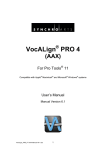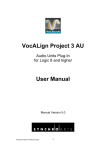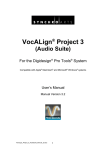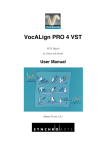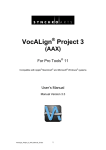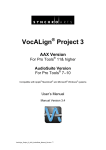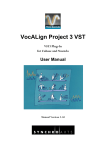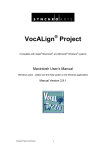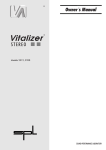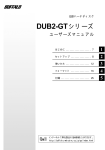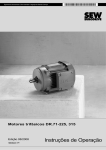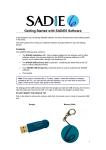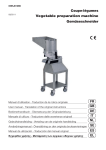Download VocALign PRO for Pro Tools Manual
Transcript
AudioSuite Plug-In For Digidesign® Pro Tools® User Manual Compatible with Apple® Macintosh® and Microsoft® Windows® systems Manual Version 1.0.5 VocALign Pro Manual 1 Contact Information Synchro Arts Limited 13 Links Road Epsom, Surrey KT17 3PP, UK Tel: +44 1372 811934 UK Tel: 01372 811934 Fax: +44 1372 817976 UK Fax: 01372 817976 Web: www.SynchroArts.com E-mail: [email protected] Online Support at: www.SynchroArts.com/support © Synchro Arts Limited 1995-2005 VocALign is a registered trademark of Synchro Arts Limited. Pro Tools and Digidesign are registered trademarks of Digidesign, a Division of Avid. All other trademarks are the property of their respective holders. VocALign Pro Manual 2 End User License Agreement PLEASE READ THE FOLLOWING LEGAL AGREEMENT CAREFULLY PRIOR TO USING THE VOCALIGN SOFTWARE PROVIDED WITH THIS AGREEMENT. USE OF THE SOFTWARE CONSTITUTES YOUR ACCEPTANCE OF THE TERMS OF THIS LICENSE. IF YOU DO NOT AGREE TO THE TERMS OF THIS LICENSE, PROMPTLY RETURN THE UNUSED SOFTWARE, MANUALS AND ACCOMPANYING MATERIALS TO THE LOCATION FROM WHICH THEY WERE OBTAINED FOR A REFUND AND YOU MAY NOT USE THIS SOFTWARE. 1. License. The application, demonstration and other software and audio accompanying this License, whether on disc, in memory or on any other media (the "Software"), and the related documentation are licensed to you by Synchro Arts Limited. You may use the Software on a single computer, make one copy of the Software for backup purposes only and physically transfer the Software from one computer to another provided that the Software is only used on one computer at a time. You may also transfer all your license rights in the Software, the backup copy of the Software, the related documentation and a copy of this License to another party, provided the other party reads and agrees to accept the terms and conditions of this License. 2. Copy and use restrictions. You are not allowed to distribute copies of the Software or the documentation. This Software is protected by the copyright laws that pertain to computer software. It is illegal to make copies of the Software, except for backups. It is illegal to give copies to another person, or to duplicate the Software by any other means, including electronic transmission. The Software contains trade secrets and in order to protect them you may not decompile, reverse engineer, disassemble or otherwise reduce the software to human-perceivable form. You may not modify, adapt, translate, rent, lease or create derivative works based upon the Software or any part thereof. You may not provide use of the Software in a network, time-sharing, or multiple user arrangement. You acknowledge that no title to the intellectual property in the Software is transferred to you and that title and full ownership rights to the Software a will remain the exclusive property of Synchro Arts Limited or its suppliers and licensors. 3. Termination. This License is effective until terminated. You may terminate this License at any time by destroying all copies and recordings of the licensed software and documentation and giving a legally binding written assurance to Synchro Arts that you have done so. This License will terminate immediately without notice from Synchro Arts Limited if you fail to comply with any provision of this License. Upon termination you must destroy all copies and recordings of the Software, related documentation and copies thereof and return to Synchro Arts the originals of the Software and documentation. 4. Limited Warranty. Synchro Arts Limited warrants that the original disc (if supplied) on which the Software is recorded is free from defects in materials and workmanship, assuming normal use, for a period of ninety (90) days from the date of purchase. If a defect occurs during this period, you may return your faulty disc to Synchro Arts Limited along with a dated proof of purchase and Synchro Arts Limited will replace it free of charge. This limited warranty is void if failure of the Software has resulted from accident, abuse or misapplication. Any replacement Software will be warranted for the remainder of the original warranty period. This warranty gives you specific legal rights and you may also have other rights which vary by jurisdiction. 5. No Other Warranties. EXCEPT FOR THE EXPRESS WARRANTY OF THE ORIGINAL DISCS SET FORTH ABOVE, SYNCHRO ARTS LIMITED GRANTS NO OTHER WARRANTIES, EXPRESS OR IMPLIED, BY STATUTE OR OTHERWISE, REGARDING THE DISCS AND RELATED MATERIALS, THEIR FITNESS FOR ANY PURPOSE, THEIR QUALITY, THEIR MERCHANTABILITY OR OTHERWISE. THE LIABILITY OF SYNCHRO ARTS LIMITED UNDER THE WARRANTY SET FORTH ABOVE SHALL BE LIMITED TO THE AMOUNT PAID BY THE CUSTOMER FOR THE PRODUCT. IN NO EVENT SHALL SYNCHRO ARTS LIMITED OR ITS AUTHORIZED DISTRIBUTORS BE LIABLE FOR ANY SPECIAL, CONSEQUENTIAL OR OTHER DAMAGES OR BREACH OF WARRANTY. 6. Severability. In the event any provision of this Agreement is determined to be invalid or unenforceable, it shall be adjusted so as to best reflect the intent of the parties to the maximum extent possible, and the remainder of this agreement shall be valid and enforceable to the maximum extent possible. 7. Entire Agreement. This Agreement is the entire understanding between the parties with respect to the subject matter hereof and replaces any previous discussion and/or agreement regarding such subject matter. No amendment to or modification of this License will be binding unless in writing and signed by Synchro Arts Limited. 8. Governing Law. This Agreement shall be interpreted and enforced in accordance with English law and the English courts shall have jurisdiction to determine any dispute. VocALign Pro Manual 3 Table of Contents. END USER LICENSE AGREEMENT ............................................................. 3 A) IMPORTANT NOTES............................................................................. 5 B) INTRODUCTION TO VOCALIGN .......................................................... 6 C) APPLICATIONS .................................................................................... 8 D) AUTHORIZATION AND DE-AUTHORIZATION .................................... 9 E) WHAT IS NEW IN VOCALIGN PRO? ................................................. 11 F) OVERVIEW OF OPERATION.............................................................. 12 G) BASIC OPERATION............................................................................ 14 H) DETAILED OPERATION ..................................................................... 17 I) USE OF PREVIEW SYSTEM.................................................................. 21 J) USE OF SYNC POINTS AND PROTECTED REGIONS ..................... 23 K) PROTECTED DUB SECTIONS ........................................................... 25 L) USE OF ALIGNMENT SETTINGS....................................................... 26 M) USE OF PATH LOCK .......................................................................... 28 N) PROCESSING MULTI-CHANNEL DUB SIGNALS ............................. 29 O) ADDITIONAL TECHNIQUES............................................................... 30 P) FOREIGN DIALOGUE SYNCHRONIZATION ..................................... 34 Q) SPECIAL OPERATIONS ..................................................................... 36 R) TROUBLE SHOOTING........................................................................ 37 VocALign Pro Manual 4 A) Important Notes In this manual, "VocALign PRO Audio Suite Plug-In for the Digidesign Pro Tools System" will be referred to simply as "VocALign PRO". This program is compatible with Pro Tools 5.1.1 or higher software running on Mac OS 9, OS X and Windows XP. VocALign PRO for the Digidesign Pro Tools system processes audio with sample rates up to 192 kHz. Acknowledgements Special thanks go to the Digidesign staff for their continued support. Thanks to Steve Cooke for providing the English voices in the demonstration audio. Thanks to Ray Gillon of G-Minor for providing the foreign voices in the demonstration audio. VocALign is developed and sold under license from Wordfit Limited. VocALign Pro Manual 5 B) Introduction to VocALign What is VocALign? VocALign is a process that lets audio editors make the timing of one audio signal automatically match the timing of another audio signal. To use VocALign PRO effectively, the audio editor should understand the basic components of the processing. How does VocALign work? VocALign works by applying varying amounts of time stretching or compression to one signal (called the "Dub") to make its energy peaks and troughs align in time with those of a “Guide” signal. It does this in 3 main steps. VocALign Block Diagram Guide Audio SPECTRUM ANALYSIS Dub Audio SPECTRUM ANALYSIS TIME ALIGNMENT ALGORITHM TimeWarping PATH AUDIO EDITING TimeAligned Dub Audio (Time or Frequency Basis) (Basic or Advanced) 1. VocALign analyzes the Guide and Dub audio signals using identical Spectrum Analyzers to produce time-varying energy patterns. 2. Then it uses advanced pattern recognition techniques to examine the energy patterns and determine the best way to “warp” time to align the Dub energy to the Guide energy. In VocALign PRO, There are two main processes or algorithms available to do this: A Basic and an Advanced.algorithm. The Time-Warping Path describes the best time-distortion of the Dub for matching to the Guide. It is important to remember this. 3. The Path is fed to an Audio Editing processor that time-compresses and expands the Dub audio to create the aligned version based on the Path. It is this edited version of the Dub that is put back into the audio editing software for the desired use. In VocALign PRO, the editing can be performed either on a time or frequency basis. In the above diagram, the audio signal names are coloured to match those in the VocALign PRO screen. VocALign Pro Manual 6 How can VocALign help? If you are a dialogue editor needing to lip-sync vocals, or a music editor needing to tighten-up lead or backing vocals, instrumental tracks, or a number of other alignment tasks, then VocALign is for you! Consider the following examples: Working without VocALign: A dubbing session, for film post production, or music production, begins with a guide track. Then the voice-over artist, singer, or musician will dub this as closely as possible. Because humans are not machines, they will not be able to get exactly in time with the Guide. This is generally not acceptable for lip-syncing, nor for double-tracking of vocals or instruments. Often, the next step is to loop-record the more tricky sections individually, but this can break-up the natural flow of the line. Lastly, the editor will use a digital audio editor to cut and nudge individual sections of the new recordings into time with the Guide. The above process can take many hours for both the artist and the editor. Working with VocALign: The above process becomes a simple matter of getting the artist to concentrate on creating a great performance, and not worry about the fact that it may drift in and out of exact sync with a previous performance. VocALign can then be used to adjust the timing by automatically applying the required amount of varying time-stretching and compression to allow the Dub to take on the same timing as the Guide. This saves studio time, saves artists time and improves the quality of your results. Most importantly, you allow your artists to produce their best performances, free from the rigidity normally associated with dubbing. What’s new in VocALign PRO ? Almost everything! Please go to Chapter E for a detailed description. VocALign Pro Manual 7 C) Applications VocALign was originally designed for Lip Syncing replacement dialogue for Film and Video post-production but it has been adapted to work successfully in all of the following applications: • Syncing replacement dialogue in Post Production for Film and Video. • Double-tracking vocal parts or instrumental parts • Tightening backing singers with one another, or with the lead vocal • Tightening backing instrumental tracks • Syncing a drum machine audio-output to a real drummer (or vice versa) • Giving a dubbed vocal the timing of a “live” vocal performance, • Changing the voice or even sex of a singer or actor’s performance. • Replacing the vocals in a music video shoot with a production track, achieving perfect lipsync. • Foreign Language Dubbing VocALign Pro Manual 8 D) Authorization and De-authorization VocALign PRO uses iLok for authorization. iLok is a USB smart key that can hold many licenses for a number of protected software products. You can have licenses from Synchro Arts and other software vendors on the same iLok. To use iLok, Pro Tools, and VocALign PRO, you will require a computer with a USB port, Mac OS 9.2 or later, or Mac OS X v10.2.8 or later, or Windows XP. What is iLok.com? The iLok.com web site lets users manage their software licenses on their iLok. With iLok.com, you can see what is on your iLok, register your licenses, move your licenses between iLoks, and receive new licenses from participating software publishers. Using software available from iLok.com, you can also identify the iLoks you currently have connected to the USB port on your computer. If you add the VocALign PRO license via a License Card, you should obtain an account and reregister your iLok at www.iLok.com so that iLok.com is aware of the change. Synchro Arts may use your iLok.com account to provide technical support. Failure to keep your account up to date may result in delays or other support issues. How to authorize VocALign PRO with an iLok If your iLok already contains a license for VocALign PRO, to authorize your software, simply have the iLok plugged into your computer while VocALign PRO is running. If your iLok doesn't contain a license for VocALign PRO? If you have purchased VocALign PRO, you will receive a license either by: a) A License Card in the VocALign PRO boxed version or b) A license deposited by Synchro Arts into your iLok.com account which you can then download to your iLok to authorize VocALign PRO. How to install your VocALign PRO iLok License and first authorize: 1. Insert the iLok into an available USB port on your computer. 2. Locate and launch the 'Authorizer' application found in the 'Authorize' folder in the Plug-In package on the CDROM. It may also be found on the root drive after basic installation. This applet is to authorize one specific Plug-in at a time. Launch it, and follow the on-screen instructions until you are prompted to insert the License Card into the iLok as in the figure below. Alternatively, when you are prompted from a Demo version, click the “Buy” button. VocALign Pro Manual 9 3. Separate the License Card (the removable metal and plastic cut-out) from the larger protective card. 4. To insert the License Card into the iLok, orient the iLok’s USB end to the left, and the loop end to the upper right as shown in the picture below. 5. Insert the metal chip end of the License Card tab (the License Card tab should have the metal chip side facing you, up, not down) You will be able to visually verify that the License Card makes contact with the iLok’s metal card reader. 6. Follow the authorizer’s on-screen instructions to complete the authorization process. You should see a window with a message similar to that below (PC version). After authorizing remove the License Card and snap it back into the protective card holder for safekeeping. Store these together in a safe place. ILok Support For further information on iLok, go to www.iLok.com. VocALign Pro Manual 10 E) What is new in VocALign PRO? Since 1995, VocALign has been used regularly on major feature films and TV shows and popular music recordings. After years of research and development, VocALign PRO has been created, which contains a host of new features and improvements over previous versions. New Features and Functions o Increased alignment accuracy:- achieved with a new and more sophisticated pattern recognition algorithm. o User settable Sync Points:- targets audio alignment at specified pairs of points in the two signals. o Protected signal blocks:- user can mark sections of the Replacement (Dub) signal to not be time-compressed or expanded during alignment. o Comprehensive audio preview options in VocALign: - allows listening to sections or the whole signal(s) before and after alignment, individually or together. o Ability to re-use an alignment path:- on another Dub signal. (Can be used for multitrack microphone recordings - e.g. simultaneous close and distant mikes) o New improved TimeMod (time compression/expansion): - optimised for single- pitch signals but maintaining the option to use an alternative TimeMod algorithm for more complex signals. o Longer maximum signal length:- Now up to 5 minutes (previously 2 minutes) o iLok authorization:- provides easy and secure license administration. Benefits of VocALign PRO Audio editors now have more control over any required audio alignment editing. Users can target the alignment of the replacement signal (Dub) to the Guide where it is required, by using the new Sync Points feature and can keep sections of the Dub from being edited by specifying Protected areas. These features will be invaluable for certain types of noisy or reverberant Guide signals and especially useful for foreign dialogue replacement. In addition, new Preview Controls allow much more detailed examination of parts or all of the two signals, together or separately, both before or after alignment to confirm the quality of editing and alignment. The other features such as improved overall quality of automatic alignment and micro-editing will save the user even more time and effort. VocALign Pro Manual 11 F) Overview of Operation 1. Tutorial To learn to use the basic functions of VocALign PRO only takes a few minutes, but for getting the best results we strongly recommend that you first try VocALign PRO on the "VocALign PRO Tutorial PT" Session. The "VocALign PRO Tutorial PT" session can be found in the "Tutorial" folder on the install CD (if you have one), or can be downloaded from: www.synchroarts.com/downloads Note - it is recommended that you DO NOT "Save" over the Pro Tools' "VocALign PRO Tutorial PT" session when exiting Pro Tools, so it can be used again. Instead, you might wish to make a copy for your own continued use. 2. Starting VocALign PRO With Pro Tools running, select the VocALign PRO Plug-in from the AudioSuite menu in Pro Tools. (It might be located in the “Other” AudioSuite submenu). 3. The Basic Steps and Options Open the “VocALign PRO Tutorial PT" session in Pro Tools. (Alternatively have your own suitable session loaded.) VocALign Pro Manual 12 The basic 3 step operation of VocALign PRO is simple: 1) Select and capture the Guide audio and then select and capture the Dub audio. 2) Align the Dub energy to the Guide and Process the audio to create an Aligned Dub. 3) Send the Aligned Dub back to the desired track in Pro Tools. Additional options in VocALign PRO allow you to preview the audio signals and also adjust or control the alignment and editing processes. The Preview controls let you: a) Adjust the selection of Guide, Aligned or Dub audio you wish to hear b) Select if you preview just the selection(s) or the whole signal. c) Select which one or pairs of signals you preview. The Alignment and Editing controls let you: a) Adjust the start and or end of the selected audio regions; b) Select the Basic or Advanced Alignment algorithm and its settings; These options are discussed in detail below. 4. An explanation of Basic versus Advanced Alignment modes The Alignment switch offers a choice between Advanced and Basic.modes. Basic Alignment - provides the user with the alignment algorithm used in all previous versions of VocALign. This algorithm is somewhat faster than the Advanced one and will generally be successful at alignment when the energy patterns of the Dub and Guide are not too dissimilar in timing or energy patterns. When Basic Alignment is used with Editing Basis set to Time, then VocALign Pro is implementing the same processing used in prior versions of VocALign. Advanced Alignment provides the user with an additional set of tools to control a number of details of the Advanced alignment process. The Advanced Alignment algorithm: 1) Users a more sophisticated pattern recognition system 2) Can protect user-selected parts of the Dub that should not be time-modified; 3) Can be influenced by user-selected Sync Point targets. The use of these will be discussed in further detail below. VocALign Pro Manual 13 G)Basic Operation 1. List of Screen Contents and Controls 1) Guide Window Selector: Click this to select Guide as next input from Pro Tools. 2) Dub Window Selector: Click this to select Dub as next input from Pro Tools. 3) Scroll Bar Use slider to move waveform position in window in conjunction with controls in 16. 4) Align Button: Click this to generate the Aligned audio energy trace in Guide Window (does not create aligned audio). 5) Process: Click to generate Aligned audio. 6) Preview on/off: Click to audition the audio selected by the Preview Control (7). 7) Preview Control: Select signals and extent of signals being previewed. 8) Capture: Click this to transfer the audio selected in Pro Tools to the Guide or Dub windows. 9) Alignment Algorithm Mode: Select Advanced or Basic mode. 10) VocALign Settings: Controls the characteristics of the alignment procssing. 11) Path Lock: Allows the current Time Warping Path to be applied to additional Dub signals. 12) Spot: If not created, creates the Aligned audio and sends it to Pro Tools into the selected Destination Track in sync with the Guide audio. 13) Information Window: Tips, Warnings and Error messages are displayed here. 14) Editing Basis: Click to choose between Time and Frequency basis for non-linear Time compression and expansion. 15) Help: Click to access the Manual. VocALign Pro Manual 14 16) Waveform display scaling and scrolling: Click to adjust the audio energy displays. a. Move waveform left and right with the < and > buttons b. Zoom in and out with the + and – buttons 17) Dub Preview Selection Bar: Click in this area to insert a Preview Selection control. 18) Dub Protection Bar: Click in this area to insert a Protected Dub area. 19) Energy Display Range: Click + or – to scale range up or down. 20) Signal Start and End markers: Can be dragged to limit processing for both Guide and Dub. 21) Dub Energy: A profile of the energy of the Dub signal in time 22) Sync Points Bar: Click in this area to insert a pair of Sync Points. 23) Guide Preview Selection Bar: Click in this area to insert a Preview Selection control. 24) Aligned Audio Trace: A representation of the energy of the new Aligned signal. 25) Guide Energy: A profile of the energy of the Guide signal in time 26) Destination Track: Selects into which Pro Tools track the Aligned audio will be placed when Spot is pressed. It is advised that you always select a destination track. (See “Special Operations” later in this Guide.) 27) Use In Playlist switch: It is advised that you always select this option. 28) Mono/Stereo Dub: Selects how multiple Dub tracks are processed. 2. Quick operation in Basic Alignment mode The following operations are suitable for first-time users of VocALign, but the advanced features are not employed. Experienced users can skip to the following Chapter. 1. Select the VocALign PRO Plug-in from the AudioSuite menu in Pro Tools. 2. Make sure “use in playlist” and “Stereo Dub” are selected in the VocALign PRO window. 3. Select the Guide audio in Pro Tools (e.g. Steve Guide 2 in the "VocALign PRO Tutorial PT" example session) 4. In VocALign PRO, click the Guide button or within the Guide Window and then press Capture. The Guide audio energy profile will appear in the Guide Window. 5. Select the Dub audio in your audio editor (Twit-Dub in the example Session) 6. In VocALign PRO, select the Dub button and click Capture. The Dub audio energy profile will appear in the Dub Window. 7. For now, select Basic under Alignment and Time under Editing. 8. Make sure Normal Flexibility appears in the Settings display. If it doesn't, click on Settings and use the pop us Settings Menu to select it. 9. Click Align to generate a yellow Aligned Dub trace in the Guide Window that lets you visually check alignment. 10. Select a destination track for the Aligned audio. (e.g. select Audio 3 for the "VocALign Tutorial PT" Session. 11. Optionally you can now skip to (12) or – if you wish to audition the Guide and Aligned signals in VocALign - click on Process to generate the Aligned waveform, click on GA and All in the Preview Control, and click Preview to start and stop playback. VocALign Pro Manual 15 12. Click Spot. The Aligned audio, if it hasn’t been created will be generated, and will be sent to the selected destination track in Pro Tools. 13. In Pro Tools, play the Guide and the new Aligned audio regions with the Dub track muted. The Aligned audio should have its timing corrected to match the Guide. Note – the above basic steps do not utilise the new features in VocALign PRO. This is covered in the next sections. REMINDER - DO NOT Save the "VocALign PRO Tutorial PT" session over the original Tutorial session when exiting Pro Tools, so it can be used again. 3. Editing Basis VocALign PRO offers two methods of editing the Dub audio. The differences are highlighted in the table below. Editing Basis Optimum Signal Requirements Audio contains only a single pitch. (e.g. one Frequency voice or one single – pitched instrument) Time Audio can be single voiced or contain complex signals. VocALign Pro Manual Advantages Speed of Editing Good for reducing editing artefacts in transients and rapid pitch changes when expanding. Slower Good for compression and maintaining musical beat. Fastest 16 H) Detailed Operation In this section, we describe the main operational steps in detail with reference to the VocALign PRO window shown below and in additional figures following in use with the Tutorial Audio. The VocALign PRO Window Sets Destination in Pro Tools for Aligned Audio Make sure this is selected Guide Window Selects Guide for Dub Window Selects Dub for Capture Selects audio for Preview Access to Help Align Dub to Guide Energy only Create aligned Dub Turn audio Preview on or off Captures Guide or Dub Sends Aligned audio to Pro Tools Selects and displays Information window for Tips, Selects TimeMod alignment setting Editing Basis warnings and errors 1. Normal Operation: 1) In Pro Tools, open a session in which there is "Guide" (original) audio contained in a single Pro Tools Region on one track and a "Dub" (replacement or new) audio in a second track. Ensure that at least a third track is available and visible in Pro Tools to receive the processed. The VocALign PRO Tutorial Session is used for the following explanation. 2) Highlight the desired portion of the Guide audio region for processing. This can be any given region or multiple regions. Your selection can begin and end in the middle of a region. VocALign Pro Manual 17 TIP: Try to capture up to around 0.25 to 0.5 seconds of “background” or “leader” audio at the beginning of your Guide audio selection. (This will assist the process to set the noise floor levels and generally allow better alignment at the start of the signal). Note: In the current version of VocALign PRO, the selected audio must be shorter than 5 minutes (300 seconds) and longer than 0.25 seconds. 3) Select VocALign PRO from the AudioSuite menu in Pro Tools. 4) In VocALign PRO Click on the Guide button or window, and then click the Capture button. The selected audio will be analysed and the energy profile is displayed in blue in the VocALign PRO Guide window. (See figure below.) The grey vertical lines indicate the start and end of the energy. 5) Using the Selector Tool in Pro Tools, highlight the desired portion of the Replacement audio region or Dub for processing. Again, this can be any given region or multiple regions. Your selection can begin and end in the middle of a region. NOTE: The Dub does not have to start at the same time of the Guide. In other words, the timecode position of the Dub is not used. The Guide's timecode is important and so is the amount of “background” captured before the Guide and the Dub. TIP: Try to capture as much or very slightly more “background” audio before the Dub signal starts than you did for the Guide. 6) In VocALign PRO, click on the Dub button or panel, and click the Capture button. The selected audio will be analysed and the energy profile is displayed in orange in the VocALign PRO DUB window (see figure below). The grey vertical line(s) indicate the start (and end) of the energy. .Examine the resulting non-processed alignment shown in the energy profiles. VocALign Pro Manual 18 7) The user can optionally perform several operations on the audio waveform itself before processing:a) The start and end boundary of the selected regions can be modified by positioning the cursor (arrow) on the grey lines at either end of the audio selections, holding down the mouse and dragging the dotted line that appears. Where the waveform turns grey indicates unselected audio energy. Releasing the mouse will leave the boundary indicator in place. b) Clicking at the boundary and dragging will leave a dotted line in place at the previous boundary and create a second line to show the new cursor position. Moving the cursor by dragging will allow a new boundary position to indicate a new energy start point. This is shown above. This operation affects the processing. c) The display can be scrolled with the scroll bars to examine the captured waveforms. d) The Horizontal Scale + and - buttons can be used to zoom in or out of the waveform to see more (+) or less (-) detail in the display windows at one time. e) The Dub waveform can be slid along to the right or left for inspection by clicking in the energy displayed and dragging in the desired direction. This does not affect the processing. f) Choose an appropriate setting (e.g. if the Dub is very long compared to the Guide, try "Maximum Compression", setting number 1.) 8) The following Alignment and Editing settings can be tried first, but further information on these features will be given in following chapters. Alignment Mode: Setting: Editing: Advanced Normal Flexibility Time 9) Click Align and visually inspect the results in the Guide window. The peaks and troughs of the yellow (Aligned Dub) energy trace should line up generally with those of the Guide as in the figure below. Note the Align button will “grey” out indicating that it cannot be pressed again. However, once any change is made to the signals or settings that require a new alignment, the Alignment trace will disappear from the Guide window, and the Align button will revert to it’s original state allowing the user to press it when required. VocALign Pro Manual 19 10) When the alignment looks satisfactory, the user can generate the Aligned Audio by pressing Process. This creates the Aligned audio into a file on the disk and the Process button will also “grey out” indicating the user cannot press it again until changes are made to the settings or signals. 11) To hear the Processed audio for this example, select All and GA in the Preview Control, and click the Preview button to hear the Guide and Aligned signals together. Select A to hear the Aligned audio on its own. 12) If the alignment is satisfactory, select a destination track (e.g. “Aligned” in this example) and click Spot to send the Aligned audio automatically to the correct time position and destination track in Pro Tools. 13) If the alignment does not look or sound satisfactory, there are several options: a) Select another Setting or Alignment mode (which will clear the aligned trace and reset the Align and Process buttons), click Align again, and examine the results. b) Adjust the "leader" audio before the start of the Guide and Dub to be roughly equivalent with the Dub "leader" being somewhat longer. c) Insert Sync Points at points of misalignment (see section J). d) Reselect and recapture the Guide or Dub audio in Pro Tools, if the selection is thought to be causing the problem. VocALign Pro Manual 20 I) Use of Preview system The audio preview system within VocALign PRO gives the editor immediate feedback about the selected audio before processing and the processed audio’s alignment and quality. The following describes the main steps in using the audio preview system. These can be done in any order. 1) Choose how much of the audio signals you want to listen to in the Preview Control. To do this, click:on• All - If you want to hear the entire signal (or signals). This is most effectively used after processing to check alignment. • Selection - If you want to hear to a selected portion of the audio signal(s). Using a selection of 1 to 2 seconds is useful for locating the beginning or ending of a portion of audio in the Guide or Dub before processing, in order to adjust Synch Points, Protected sections, or the energy start and end markers. If you choose Selection, you will need to select a portion of the Guide, Dub or both. This is shown using the Preview Selection Indicator, described below, for the Guide and/or Dub signals. Preview Selection Indicator a) If a Preview Selection Indicator is not present, it can be created manually, simply by clicking within the Guide or Dub Selection Bar anywhere to the right of its Selection icon. Click anywhere in a Selection Bar b) To adjust the start or end of the selected audio, click and drag the appropriate speaker icon of the Preview Selection Indicator to move the end points of the audio Selection. A fine line will appear in the corresponding Guide or Dub Window to show the exact position of the audio Selection start and finish. c) To move the positioning of the entire selection keeping its length the same, click in the inner portion of the Preview Selection Indicator and drag it. VocALign Pro Manual 21 Click and drag to move whole Preview Selection Indicator Click and drag to move start or end 2) Select which signal or signals (pairs) you wish to hear. G = Guide, D = Dub, A = Aligned In the image above, both the Guide and Aligned signals will be previewed. The dots show the signal’s displayed colour. 3) Click the Preview button to start playback of the Selected signal(s). Clicking it again will stop the playback. 4) If you select to preview the Aligned audio (by itself or with another signal) ensure the Aligned audio has been created. If it hasn’t, turn the Preview button off, and click the Process button. 5) Changes can be made during preview to any of the above selection methods, and the revised selection will be heard in the subsequent pass of the preview playback. 6) To delete a Preview Selection Indicator, hold down the Alt key on your computer keyboard while clicking anywhere in the Preview Selection Indicator. TIPS for Preview: • Selections of 1 to 2 seconds are recommended for locating beginning and ends of audio within the Guide and Dub before processing, whereas ALL is best used for reviewing alignment. • If there is no aligned signal but it is selected for Previewing, then silence will be output instead. The user should stop the preview, create the aligned signal by pressing Process, and restart preview. • If the preview Selections are less than 0.5 seconds, there is likely to be a occasional silent section during playback. This is due to the Pro Tools preview system operation. VocALign Pro Manual 22 J) Use of Sync Points and Protected Regions VocALign PRO offers the user further optional control of the Alignment process in the Advanced mode, shown selected below by pressing the Advanced button. 1. Synch Points In this mode, the user can manually create and set Synch Points, which are targets or “suggested” alignment points between the Guide and the Dub for the alignment algorithm to try to match. Synch Points allow the user to influence the alignment of the final output. Note: Synch Points can be set which the alignment algorithm cannot achieve. They can be ignored completely if their position makes it impossible to align the audio before and after each Synch Point. Sometimes, choosing a Setting of “High Flexibility” in the Setting control will allow more Synch Points to be hit if they are being ignored in other settings. Synch Points can be set manually, or automatically. Pressing the Automatic button shown above will let the alignment algorithm inspect the signal for the most obvious synch points (such as between breaks between high energy sections of signals). For more detailed alignment, Synch Points can be created manually, simply by clicking within the Synch Point Bar to the right of the Synch Point icons. As shown below, this will insert a pair of Synch Points showing a colour transition in the Guide and Dub energy waveforms at the Synch Point. Each point in the pair can be moved independently by clicking and dragging to the desired points in the Guide and Dub. A connecting line will link the pair. To delete a Synch Point pair, hold down the Alt key on your computer keyboard while clicking on one of the two points. VocALign Pro Manual 23 To delete all Synch Points, press the Clear button. Tips for Synch Points: a) Do not add Synch Points to silent parts of the Dub. The results are unpredictable. Try to anchor them to a voiced part of the Dub and Guide. b) It is better to use more than one Synch Point to force the alignment of a section of the Dub to a section of the Guide. If needed, placing one Synch Point at the start of the section and one at the end of the section will usually work well. You can refine the alignment further by adding more and more Sync Points before and after each section until you get the alignment you want. c) To obtain the greatest influence of Synch Points, use a Setting with Normal or High Flexibility. VocALign Pro Manual 24 K) Protected Dub Sections Sometimes, it is desirable to not allow the Dub to be time stretched or compressed in a particular section. VocALign PRO allows the insertion of any number of Protected Sections into the Dub window. It is important to note that: a) Protecting part of a Dub does not fix its time position in the final output and b) Long protected regions may limit VocALign’s ability to align the remaining 'unprotected' regions of the Dub. To insert a Protected Section, click to the right of the Protected icon anywhere in the bar under the Dub Window Click in this area This will insert a pair of Protected lock icons in the Protected Section Bar and a corresponding transparent red panel in the Dub window clearly showing the range of the protection from timecompression or expansion during alignment (see figure below). Clicking and dragging the lock icons in the Protected Section Bar will move the corresponding end points of the Protected Section. To remove a Protected section, hold down the Alt key on your computer keyboard and click on one of the two Protected (lock) icons. TIPS for Protected Sections: a) It is better not to start a Protected section in a silent part of the Dub. Try to anchor the Protected section to a voiced part of the dub. Doing this will make the final alignment more predictable. b) Try to keep the protected regions as short as possible. c) If there is audio in the Dub which is NOT in the guide and which is also after some silence in the Dub and the alignment is not correct at this point, try the following. Put a protected section extending from the end of the piece of correct dub audio before the silence, through the silence and into the unmatched Dub. 2. Further Tips and Advice For further information on operation and use of these new features, visit www.synchroarts.com/support . VocALign Pro Manual 25 L) Use of Alignment Settings In addition to selecting which Alignment algorithm to use, the user has control over the internal Settings, which greatly affect how the alignment performs. Clicking to the right of “Setting” in the circled arrow or on the Active Setting will bring up the Settings Pre-sets window, from which the user can select which Setting is active. NOTE: The names in the window will be the same for both the Advanced and the Basic Alignment mode, but the effect of the Setting is very different in the two modes. Click here to bring up Settings List Active Setting 3. Basic Mode These settings are the same as previous versions of VocALign and the comments on Characteristics in the chart below relate to comparisons amongst the Basic Settings only. Setting Main characteristics Low Flexibility Normal Flexibility High Flexibility Maximum Compression Maximum Expansion Alignment is not very flexible, sound quality may be best. (Default): Recommended trying this first as it works best in most cases. Alignment is the most flexible of the Basic Settings. Tries to match the Guide by time compressing the aligned audio as much as possible. Tries to match the Guide by time-expanding the aligned audio as much as possible. 4. Advanced Mode In general, in addition to supporting Synch Points as targets for alignment, the Advanced mode allows considerably higher amounts of time compression and expansion to occur and provides increased accuracy over the Basic mode. The influence of the Sync Points during the computation of the time-alignment Path depends on the Active Setting and goes from strong (high influence) to weak (low influence). In general, the less flexible the Setting, the smaller the number of time-alterations there are likely to be. This means there will be fewer edits and less chance of creating audible editing artefacts. VocALign Pro Manual 26 i.e. the lower the flexibility, the higher the quality is likely to be, but the chances for mis-alignment are higher. Correspondingly, the more flexible the Setting, the lower the quality could become. Of course, these effects are also signal dependent. The following chart clarifies the differences between the Advanced mode settings. Setting Low Flexibility Influence of Synch Points Weak Main characteristics o This is the least flexible setting and produces the highest quality output. o It can compress or expand a section of audio up to a maximum of two times. o It also assumes that the Guide and Dub audio are already pre-aligned to within about two seconds. You can use Synch Points with this setting but they have a weak influence, so in general they will have only a small effect on the alignment. This setting is suitable for aligning audio where the main blocks of the Guide and Dub are already fairly well aligned. o Normal Flexibility Medium o This is the normal Setting for most users and generally gives a good quality output. o It can compress or expand a section of audio up to a maximum factor of three times. o It makes no assumption about the initial alignment of the Guide and Dub. Synch Points, if used, have a fairly strong influence on the alignment. This is the most useful Setting and should be the first one a user tries. o o High Flexibility Maximum Compression Maximum Expansion VocALign Pro Manual Strong o This is the most flexible Setting but its output can sound distorted on sibilants and breathy noises. o It can compress or expand a section of audio up to a maximum factor of five times. o It makes no assumption about the initial alignment of the guide and dub. o o Synch Points, if used have a strong influence on the alignment. In some cases, the Alignment algorithm may not be able to find a path through the Synch Points and will generate an error message. o This is a useful setting for difficult alignments. It also a good setting for using Synch Points. o This is very similar to High Flexibility but favours compression over expansion. o This is useful when the Dub is much longer than the Guide. o This is very similar to High Flexibility but favours expansion over compression. o This is useful when the Dub is much shorter than the Guide. Medium Medium 27 M) Use of Path Lock Referring back to the diagram in the introduction in Chapter B, the output of the time alignment algorithm is the Time Warping Path. This “Path” contains the time-distortion information required for editing the Dub. There are sometimes situations where more than one Dub signal needs to have the same time distortion applied in order to maintain accurate alignment with a common Guide. Generally, the alternative Dub signals were recorded at the same time; for example, in the case of a multiple microphone recording of dialogue on a set in which there might be both a radio mike and a boom mike recording the dialogue. Path Lock simply allows the editor to create an alignment of a Dub Number 1 to a Guide and then click Path Lock (as shown in the Figure below) to “lock down” all the VocALign PRO alignment controls, load in another Dub, and apply the same time-based editing requests to subsequent Dub Numbers 2 , 3, 4, … etc. The purpose of this is to maintain accurate time-aligned edits. Note, it is not generally appropriate to use Path Lock when events in the multiple Dubs differ in timing within the recordings. Also, to maintain audio quality, the use of Path Lock does not maintain precise phase accuracy for each edited Dub signals. This is because VocALign PRO does not assume that each of the Dub signals used will have identical pitch characteristics at each of the points which require editing. VocALign Pro Manual 28 N) Processing Multi-Channel Dub Signals Firstly, when processing multi-channel Dub audio, ensure the following Audio Suite switch (if it is showing) shows Stereo Dub. NOTE: If this switch is set to Mono Dub, only one of the Dub’s input channels will be Aligned and copied to each of the multi-channel output channels. The Stereo setting allows each input Dub channel to be edited to a corresponding Aligned Dub channel in the Spotted output. Next, it is important to recognize there are two main methods of processing a multi-channel Dub and a related method for processing multiple signals as Dubs to the same Alignment Path. The choice of which is best to use depends upon the initial relationship between the audio in the channels and the desired phase relationships between the output channels. The following chart describes the options. Dub Signal Type One multichannel audio signal Multiple audio signals Required Relationship Advantages and Disadvantages Settings All channels must be edited at the exact same points. (e.g. normal stereo) Maintains exact phase between channels, but possible editing artefacts can arise if content differs greatly between the channels Alignment – Basic Path Lock – OFF Editing Basis - Time All channels should be edited at approximately the same points in time, but more important to maintain signal integrity in each channel. Minimizes editing artefacts but allows looser phases relationships between channels. Alignment – Basic Path Lock – OFF Editing Basis- Frequency Each channel in each signal can be edited independently, but editing will follow the same Alignment Path. Minimize editing artefacts but phase relationships between signals in channels is only approximate. Alignment – Advanced Path Lock – ON Editing Basis - Time VocALign Pro Manual 29 O)Additional Techniques Although the Advanced Alignment algorithm can deal with aligning differing signals with much less user intervention than before, a number of simple adjustment techniques can assist problematic alignment, particularly at the beginning and end of audio regions. Although mentioned previously, these techniques will be explained further. 1. Altering the Selected Region The length of the Dub being processed can be reduced in VocALign PRO without having to return to Pro Tools. You may wish to do this to align only the beginning part of the Dub and leave the following part unaligned. These examples use the VocALign PRO PT Tutorial Session (Steve Guide 2 and Twit-Dub). 1) Move the cursor to the grey vertical line at the end of the Dub energy waveform. Hold down the mouse button, and a dotted line should appear. While holding down the mouse button, drag the dotted line to the left and release it at the point shown in the next picture. (This does not need to be exactly the same point). 2) The end of the Dub should be grey as shown below. 3) Next, click on the grey vertical line now positioned at the colour boundary and the dotted line should appear. Drag the dotted line left again whilst holding the mouse down to the point shown below and release the mouse. 4) The picture above indicates that the selected Dub region for processing is now much shorter than the Guide selected region. 5) Click on Align and the following result should appear. This shows that only the Selected Dub audio has been aligned to the corresponding section of the Guide. VocALign Pro Manual 30 6) Clicking Process, followed by the Preview button will audition the Aligned audio with the Guide if GA is selected. 2. Processing Signals with Different Lengths In general, it is common for either the Guide or Dub to be part of a much longer audio region than the other is. In most cases, the Guide region is longer (being part of a long transfer), while the Dub is a shorter section. In the example in the Demo Session, we have a Dub that is longer than the Guide and even contains extra audio at the end of the region that is not in the Guide. 1) Open the VocALign PRO Tutorial PT session. 2) The Guide (Steve Guide2) and Dub (Twit-Dub) should be played together to hear how the Dub is not only much slower and longer than the Guide but it has extra audio at the end. 3) As in previous examples, highlight in Pro Tools and capture all of Steve Guide2 and all of Twit-Dub as the Guide and Dub (as shown below for the Dub) respectively. Note that even though the user could chose to stop the Dub audio selection in Pro Tools before the last part of the audio, this example will show that when the Guide audio stops, if there is more Dub selected to process, it will simply be added on after the alignment activity required by the Guide is completed. VocALign Pro Manual 31 4) Click on the Align button in VocALign PRO and the resulting aligned (yellow) trace over the Guide should appear as shown below: In this case, the Dub audio filter waveform is aligned up to the point where the Guide selected waveform (shown in blue) stops, and then the rest of the Dub filter waveform is joined on but without any modification. Process and Preview the results (in the All Preview setting) in VocALign PRO and note that while the beginning of the Dub is aligned up to the colour change, the end of the Aligned Dub is unedited. 3. Aligning Multiple Takes An additional useful feature of VocALign PRO is that once a Guide or Dub is captured, you may recapture either of the signals without affecting the other. There are many advantages to this, and in this example, we will use this feature to align three different vocal tracks. 1) Open the VocALign PRO Tutorial PT session in Pro Tools and locate the three regions shown below. Play these three tracks together to hear how they are aligned in this session. 2) Highlight the audio within the region "BG-Guide1" in track “Guide” as shown. Capture this as the Guide. VocALign Pro Manual 32 3) In Pro Tools, highlight and capture the BG-Voice2 region as shown below as the Dub. 4) Align this, check the sync and if it is correct, set the Destination Track in VocALign PRO to “Aligned1” and click Spot. The edited region should appear in Pro Tools track “Aligned1”. 5) Highlight and capture the BG-Voice3 region as shown below as the Dub. 6) If using Basic Alignment mode, Change the Setting to “Low Flexibility”. This is to minimize the amount of editing on this voice. In Advanced Alignment mode, use “Normal Flexibility”. 7) Click Align and examine the alignment. Set the destination track to “Aligned2” and click Process. The edited region should appear in Pro Tools track “Alinged2”. 8) In Pro Tools, mute tracks “Dub” and “Dub2”, and play tracks “Guide”, “Aligned1“ and “Aligned2” together. They should be tightly synchronized. VocALign Pro Manual 33 P) Foreign Dialogue Synchronization This section discusses the problems that arise in foreign language dialogue replacement (dubbing) and how and when VocALign PRO can be used to assist this process. Users can also check www.SynchroArts.com/support for the latest tips and suggestions. 1. Overview The variability in foreign dialogue signals is virtually infinite. Consequently, the quality of lip synch that can be achieved in Foreign Dialogue Replacement (often called Dubbing, Doublage, etc.) depends on many factors including:• • • The quality of the translation. The accuracy of the timing of the new dialogue recording. The ability of the editor to modify the new dialogue. VocALign PRO will attempt to align one set of audio modulations to another, no matter what the audio signals are. Therefore, it can be used to align the modulations of recorded dialogue in one language to recorded dialogue in another language. Thus, when there is an audio Guide Track that is in good synch with the lip movements in the picture, VocALign PRO can generally be used to improve the accuracy of the lip sync of the replacement foreign dialogue. Sometimes, unfortunately, the Guide Track may not be in close sync with the picture. This can occur if the Guide Track is itself already badly dubbed or in a different language from the original location recording. In this case, even if VocALign PRO matches the new audio modulations to the Guide, they will be out of sync, just as the Guide is. An experienced editor must align the audio by ear and eye in this case, and VocALign PRO is not likely to be of much assistance. Also, the Guide track used for dubbing can sometimes contain music and effects. This makes the job for VocALign PRO harder, but not impossible, since it must "ignore" the music and effects in the Guide Track and match only to the dialogue. Lastly, the translation may demand that the two audio signals are vastly incompatible and result could never be totally satisfactory. In this case, the best result sometimes comes from making the two audio signals start together and, if possible, end together. 2. Use of VocALign PRO If the Guide Track dialogue synchronizes well with the on-screen lip movements, and the replacement foreign dialogue has been translated and recorded to achieve good lip sync, then VocALign PRO should be able to improve the quality of lip synch. VocALign Pro Manual 34 The two unique features that will help in addition to VocALigns’ ability to synch automatically are: a) The identification and use of Sync Points by the dialogue editor, which can be used to target and align the most important and visible synchronization points between the Guide and Dub audio; b) The ability for the editor to create Protected sections of the Dub dialogue from being unnecessarily edited (e.g. when no on-screen lip movements are present in a part of a section of dialogue or editing would time-distort all or some of the replacement audio). 3. General Advice and Tips Dialogue Editors should be very familiar with the use of VocALign PRO on dialogue replacement in the same language before attempting to use it for foreign dialogue replacement. The following additional tips are suggestions and not rules, so the user should not only try these techniques, but also experiment further. Every line of dialogue is likely to need individual attention. Break the dialogue into shorter, appropriate length sections. Use of VocALign PRO’s Advanced time alignment means that peaks in energy patterns will dominate the alignment process and can provide considerable flexibility, particularly in low level signals between sentences. Advanced mode should always be tried first. If using Basic alignment settings, the user must remember that VocALign PRO is deliberately restricted to stretching a part of a signal by a factor of 2.0 (100% expansion) and compressing it by a factor of 1/2 (50% compression). If VocALign PRO is trying to expand or compress a gap in the speech, and it has used up its allowance, it may try to expand or compress the neighbouring speech. This means, for example, that if gaps in the new and replacement dialogue appear in different places or are of very different durations, after modifying the gap region, VocALign PRO in Basic mode might also have to expand or compress the replacement speech signal near the gap, to best align the modulations. This may lead to unwanted effects. In this case, the user should break the signal into sections that can be individually treated. Sync up only the beginning of a line To get only the beginning of a new line of dialogue to sync up with the Guide, use the "latching" technique described in the next chapter. This means only selecting perhaps a second at the start of the Guide that VocALign PRO will try to sync the dub start to, and the entire replacement line for the Dub will follow, but without editing. Minimize the amount of VocALign PRO's Time Compression and Expansion If VocALign PRO is making too many timing modifications and creating unnatural sounding speech, try using the "Low Flexibility" setting. VocALign Pro Manual 35 Q)Special Operations 1. “Latching” To align just the start of the Dub with the Guide (and leave the rest of the Dub unprocessed), capture only 0.25 to 1.0 second of the Guide and capture the Dub as normal. Alternatively, use the technique described in Section 1 of Chapter O to adjust the Guide energy being used to the first second or so. Reverb tails To stop the end of a Dub from being stretched to wrongly "fit" to a noisy or reverberant Guide, stop the captured end of the Guide 0.25 to 1.0 second before the Guide signal of interest ends and capture the Dub as normal. Alternatively, insert Sync Points or “Protected” areas to shape the end of the Dub as required. Destination Track set to “none” Normally, the VocALign PRO user is advised to always select a “destination track” in the plug-in. However, if the destination track is set to “none” and aligned audio is “processed”, it will be returned to Pro Tools in sync with the original Guide audio, and on a track where the cursor is present. Once aware of this fact, the user can make use of this to speed-up operations. a) Make sure “use in playlist” is selected. b) Ensure that the Dub audio is close to the Guide audio in the Pro Tools timeline. c) Select the Guide audio and send it, as normal, to VocALign PRO. d) Select the Dub audio and send it to VocALign PRO, making sure the Dub audio remains highlighted. e) Once aligned, press “Process” with “destination track” set to “none”. The aligned audio will be sent to the track where the Dub was taken from. In this way, Dub audio can be aligned by VocALign PRO and updated in Pro Tools. There is then no need for an additional track to receive the “aligned” audio. VocALign Pro Manual 36 R) Trouble Shooting Some commonly occurring problems are listed here: Problem: “VocALign PRO does not appear in the AudioSuite menu.” Solution: Mac users: Check that the file "VocALign PRO” has been copied to the Plug-Ins folder within the DAE folder in your “System Folder”. Windows users: Check that the files "VocALign PRO.dpm" and "VocALign PRO.dpm.rsr" have been copied to the Plug-Ins folder within the DAE folder. Problem: “The aligned audio appears in an incorrect destination track.” Solution: Make sure you have selected a destination track before pressing “Process”. If “none” is the selected destination track, the aligned audio will appear in the currently selected track, in sync with the Guide. If you have renamed Pro Tools tracks whilst the plug-in window is open, the drop-down destination track list will not reflect those changes until the plug-in window is closed and opened again. Problem: “No aligned audio appears in the audio editor”. Solution: Make sure you have selected “use in playlist” in the VocALign PRO window. Further help and advice can be found on the Synchro Arts website at http://www.SynchroArts.com/support VocALign Pro Manual 37





































